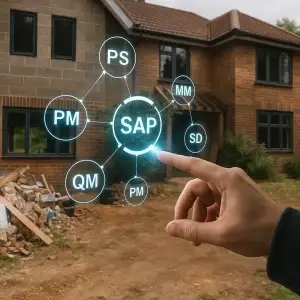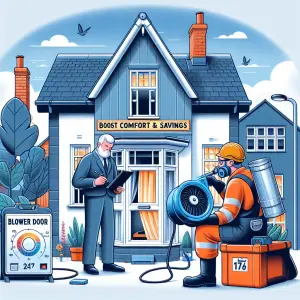Understanding Operational Carbon Emissions
Operational carbon emissions are a significant concern in the quest for a sustainable environment, particularly in the UK where there is a strong emphasis on reducing our carbon footprint. These are the carbon emissions produced during the operation of a building. This includes the energy consumption required for heating, cooling, lighting, and running appliances. It’s worth noting that operational carbon emissions are distinct from embodied carbon emissions, which are associated with the materials and construction processes used to build a structure. Given the pressing need to address climate change, reducing operational carbon emissions has become a key focus for many businesses. At Ratio Seven, we understand the importance of this task and are committed to helping you achieve significant reductions through our comprehensive range of services.
The Role of Airtightness in Reducing Operational Carbon Emissions
Airtightness plays a critical role in minimising operational carbon emissions. A building with poor airtightness allows uncontrolled leakage of air through the building envelope, resulting in a higher demand for heating and cooling. This increased energy consumption directly translates to higher operational carbon emissions. Therefore, assessing and improving the airtightness of a building is an effective strategy for reducing these emissions. By ensuring that a building is well-sealed, we can significantly reduce the energy required to maintain a comfortable indoor environment. This is where our airtightness testing services at Ratio Seven can be particularly beneficial, helping you identify and remedy areas of air leakage.
Air Permeability Testing Explained
Air permeability testing, also known as air tightness testing, measures the amount of air leakage in a building. This test identifies the points where air is entering or escaping, enabling targeted improvements to be made. Conducted using a specialised fan, placed in an exterior doorway, it creates a pressure difference between the inside and outside of the building. The resulting airflow demonstrates the level of air permeability. Our team at Ratio Seven utilises this data to provide actionable strategies to improve your building’s airtightness. By addressing these areas of weakness, you can significantly reduce your energy consumption and, consequently, your operational carbon emissions.
SAP Calculations and Their Importance
SAP (Standard Assessment Procedure) calculations are integral to building a low-energy and low-carbon future. The SAP methodology, used in the UK to assess and compare the energy and environmental performance of dwellings, ensures compliance with Building Regulations. These calculations take into account various elements such as insulation levels, heating systems, and hot water provision. At Ratio Seven, we specialise in providing precise SAP calculations to help you understand your building’s energy performance. Optimising these aspects not only reduces your operational carbon emissions but also leads to significant cost savings in the long run.
Acoustic Sound Testing and Energy Efficiency
While it may seem unrelated, acoustic sound testing can also contribute to energy efficiency. By ensuring that a building is well-insulated against noise, you are also enhancing its thermal properties. Effective sound insulation often goes hand in hand with airtightness and thermal insulation, leading to reduced heating and cooling needs. Our acoustic sound testing services at Ratio Seven ensure that your building meets the required standards for sound insulation, indirectly supporting efforts to minimise operational carbon emissions.
Operational Carbon Emissions: A Focus on the UK
In the UK, the government has set ambitious targets to reduce carbon emissions. These targets are part of the broader goal to achieve net-zero greenhouse gas emissions by 2050. Reducing operational carbon emissions in buildings is a significant part of this strategy. Strict regulations and standards have been implemented to ensure new and existing buildings are energy efficient. At Ratio Seven, we provide services that not only help you comply with these regulations but also exceed them, contributing to a greener and more sustainable future.
Airtightness and Carbon Emission Reduction
Improving a building’s airtightness is a proven method for reducing operational carbon emissions. When air leakage is minimised, the building’s heating and cooling systems operate more efficiently, consuming less energy. This reduction in energy consumption leads to lower carbon emissions. Our airtightness testing services at Ratio Seven are designed to help you achieve optimal airtightness, providing detailed reports and recommendations for improvement. By implementing these recommendations, you can significantly reduce your carbon footprint.
Understanding the Impact of Airtightness on Reducing Operational Carbon Emissions in Buildings
The impact of airtightness on operational carbon emissions cannot be overstated. A building that leaks air requires more energy to maintain comfortable temperatures. This increased energy demand leads to higher operational carbon emissions. By improving airtightness, you are effectively reducing the load on your heating and cooling systems. This not only cuts down on energy consumption but also reduces wear and tear on your HVAC systems, leading to lower maintenance costs. At Ratio Seven, we provide comprehensive airtightness testing services to help you achieve these benefits.
Carbon Emission Reduction Strategies
Reducing operational carbon emissions requires a multi-faceted approach. Improving airtightness is an essential step, but it should be complemented by other strategies such as upgrading insulation, installing energy-efficient windows, and utilising renewable energy sources. Energy monitoring and management systems can also play a crucial role. These systems provide real-time data on energy consumption, enabling you to make informed decisions on how to reduce your energy use. At Ratio Seven, we offer a range of services that work together to create a holistic approach to carbon emission reduction.
Related Services to Air Permeability Testing
Air permeability testing is just one part of the puzzle when it comes to reducing operational carbon emissions. To achieve comprehensive results, it should be used in conjunction with other services like SAP calculations, thermal imaging, and energy performance certificates (EPCs). SAP calculations provide a detailed picture of your building’s energy efficiency, identifying areas for improvement. Thermal imaging can pinpoint heat loss areas, guiding targeted upgrades. EPCs offer a clear benchmark of your building’s energy performance and potential improvements. Our team at Ratio Seven is equipped to provide all these services, ensuring a thorough approach to reducing your operational carbon emissions.
Benefits of Reducing Operational Carbon Emissions
The benefits of reducing operational carbon emissions extend beyond environmental impact. For businesses, these reductions can translate into significant cost savings. Lower energy consumption means reduced energy bills, while improved building performance can lead to lower maintenance costs. There are also regulatory benefits, as buildings with low operational carbon emissions are more likely to comply with current and future legislation. At Ratio Seven, we are committed to helping you realise these benefits through our suite of services.
The Future of Operational Carbon Emissions in the UK
The future of operational carbon emissions in the UK is likely to be shaped by increasingly stringent regulations and a growing emphasis on sustainability. As the government continues to push towards net-zero emissions, businesses and homeowners will need to take proactive steps to reduce their carbon footprint. This will involve not only complying with existing standards but also staying ahead of new regulations. At Ratio Seven, we stay abreast of the latest developments in energy efficiency and carbon reduction, ensuring that we can provide our clients with the most up-to-date advice and services.
Why Choose Ratio Seven?
Choosing Ratio Seven means partnering with a company that is dedicated to reducing operational carbon emissions through expert advice and comprehensive testing services. Our team of professionals is passionate about sustainability and committed to helping you achieve your energy efficiency goals. Whether you need airtightness testing, SAP calculations, or any of our other specialised services, we are here to support you every step of the way. With our help, you can not only meet regulatory requirements but also make a meaningful contribution to the fight against climate change.
Operational Carbon Emissions airtightness and carbon emission reduction
Operational carbon emissions are a critical concern in the building industry, impacting both environmental sustainability and regulatory compliance. Improving airtightness is a key strategy in reducing these emissions, as it helps to minimise energy consumption for heating and cooling. At Ratio Seven, we offer a range of services designed to help you reduce your operational carbon footprint. From air permeability testing and SAP calculations to acoustic sound testing and more, we provide the expertise and support you need to make your building as energy-efficient as possible. By taking these steps, you can not only comply with UK regulations but also contribute to a more sustainable future.




